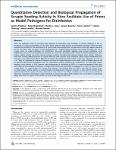Quantitative detection and biological propagation of scrapie seeding activity in vitro facilitate use of prions as model pathogens for disinfection.
Pritzkow, Sandra
Wagenführ, Katja
Daus, Martin L.
Boerner, Susann
Lemmer, Karin
Thomzig, Achim
Mielke, Martin
Beekes, Michael
Prions are pathogens with an unusually high tolerance to inactivation and constitute a complex challenge to the re-processing of surgical instruments. On the other hand, however, they provide an informative paradigm which has been exploited successfully for the development of novel broad-range disinfectants simultaneously active also against bacteria, viruses and fungi. Here we report on the development of a methodological platform that further facilitates the use of scrapie prions as model pathogens for disinfection. We used specifically adapted serial protein misfolding cyclic amplification (PMCA) for the quantitative detection, on steel wires providing model carriers for decontamination, of 263K scrapie seeding activity converting normal protease-sensitive into abnormal protease-resistant prion protein. Reference steel wires carrying defined amounts of scrapie infectivity were used for assay calibration, while scrapie-contaminated test steel wires were subjected to fifteen different procedures for disinfection that yielded scrapie titre reductions of ≤101- to ≥105.5-fold. As confirmed by titration in hamsters the residual scrapie infectivity on test wires could be reliably deduced for all examined disinfection procedures, from our quantitative seeding activity assay. Furthermore, we found that scrapie seeding activity present in 263K hamster brain homogenate or multiplied by PMCA of scrapie-contaminated steel wires both triggered accumulation of protease-resistant prion protein and was further propagated in a novel cell assay for 263K scrapie prions, i.e., cerebral glial cell cultures from hamsters. The findings from our PMCA- and glial cell culture assays revealed scrapie seeding activity as a biochemically and biologically replicative principle in vitro, with the former being quantitatively linked to prion infectivity detected on steel wires in vivo. When combined, our in vitro assays provide an alternative to titrations of biological scrapie infectivity in animals that substantially facilitates the use of prions as potentially highly indicative test agents in the search for novel broad-range disinfectants.
No license information

